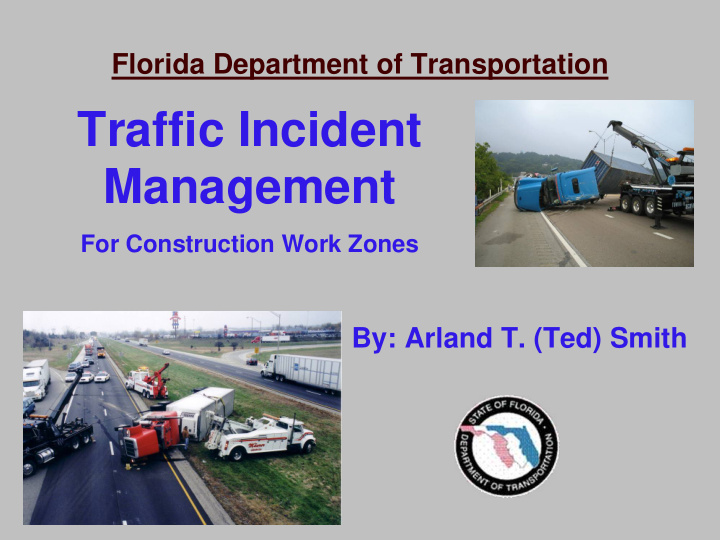



Florida Department of Transportation Traffic Incident Management For Construction Work Zones By: Arland T. (Ted) Smith
Traffic Incident Management (TIM) 60% of highway congestion caused by incidents 13-33% of crashes are secondary to earlier incidents Responder injuries a significant concern
Traffic incidents play a major role in the public perception of their highway system
Cost of Congestion in Florida 2010 * Region 1990 2000 Jacksonville $ 95 M $ 135 M $ 380 M Orlando $135 M $ 690 M $ 1.40 B Ft Laud/Hollywood $150 M $ 810 M $1.50 B Tampa/ St Pete $325 M $ 745 M $1.10 B Miami/Hialeah $550 M $1.365 B $2.10 B Urban Mobility Report prepared annually by Texas Transportation Institute [Texas A&M] *Estimated FHWA indicates that incidents can account for well over half of the congestion
Managing traffic incidents in major work zones
Why Traffic Incident Management in construction zones Supports Work Zone Safety (2007-835 Killed, 40,000 Injured) Incidents have a huge economic impact on state economy Trucks especially hauling construction material need to be delivered be ‘just in time’ (project costs) Construction worker productivity impacted (project delay) Traffic incidents bring increased liability risks agencies and to contractors
TIM Elements for Highway Construction Work Zones Quick Clearance agreements (Contractors, FHP, Fire Dept, FDOT) with a Concept of Operations Everyone involved in the project trained and committed to Florida’s “Open Roads” Policy Active speed enforcement on project approaches (parked squad cars have limited value) On-site police units specifically trained to direct immediate response and aggressive clearance
TIM Elements for construction zones ‘Quick Clearance’ of minor crashes with roving service patrol wreckers and police units using push bumpers Crash investigation and enforcement sites at strategic locations, relocated during project stages Immediate tow away within project limits, “Immediate Tow Zone” posted at project limits Contractor equipment approved and ready for clearing incidents ( loaders, sweepers, cranes) Alternate access points, barrier wall offsets with shoulders designed for emergency vehicles
TIM Elements for construction zones Detailed guidelines for enforcement officers for their safety Activity and productivity expectations ,data collected Utilize training, outreach and media briefings explaining the TIM plan Full utilization of ITS during construction: CCTV, speed sensors, DMS, wireless to TMC Projects must also be designed with permanent TIM features to assure the efficient long term operation of the highway by Transportation and Public Safety Agencies
Recommend
More recommend